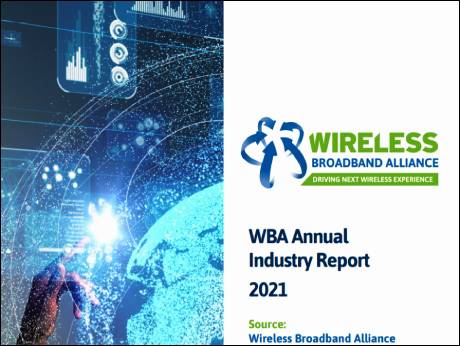
November 24, 2020: The next year, 2021, promises to be a significant year in the world of Wi-Fi, according to this year’s Wireles Broadband Alliance (WBA) Annual Industry Report.
With COVID-19 and global lockdowns, 2020 has been a challenging year which has reinforced the important role that Wi-Fi has to play in keeping the world connected. During lockdown, traffic patterns inevitably shifted from an office setting to a home setting, with many cellular and broadband providers seeing massive, sustained increases in traffic across residential areas. The stability of Wi-Fi has arguably been the unsung hero of this situation – it has kept a lot of things moving and working at a time when failure would have resulted in a much bleaker situation for people and business.
As 2021 unfolds Wi-Fi will be important to businesses and consumers in many different ways, and the richness and diversity of services it enables are growing in line with new spectrum, standards and business models.
With Wi-Fi 6 going mainstream in 2021 and Wi-Fi 6E developments closely following, these final results highlight how the Wi-Fi platform is constantly evolving and so enabling additional services and business cases. Despite the challenges of 2020, the clear roadmap to next generation standards – with enriched spectrum, OpenRoaming and convergence with 5G – is clearly instilling high levels of confidence in Wi-Fi to support a very wide range of applications and revenue streams in the coming year.
As well as reviewing the year, the report addresses emerging trends and business models in key vertical markets such as Retail, Aviation, Hospitality, Smart transportation, IoT, healthcare and general industry. In addition, it charts the progress of technology trends and developments including standards evolution, OpenRoaming, Mesh Wi-Fi, and Mobile edge Computing. All these topics and more are covered in this year’s Report. We hope it provides a valuable guide to the varied and influential work the WBA carries out in the world of Wi-Fi and unlicensed spectrum technology; and inspires you to take part in the rich and business-critical agenda that lies ahead in 2021.
We share the Executive Summary of the report:
In last year’s report we predicted that 2020 would be a landmark year for Wi-Fi. This has proved true,though not quite as we anticipated. Wi-Fi took center stage in the new reality imposed by COVID-19, which has seen millions of people working from home or studying online for the first time.
That has made high quality Wi-Fi connectivity not just a convenience but an essential enabler of the new way of living. The new levels of speed, security and reliability this demands are possible because of years of innovations, from multi-access point mesh to Wi-Fi 6, from very high throughput to ultra-low latency.
Working from home has taken centre stage this year, but the pandemic will force users everywhere, including many enterprises, industries and cities, to turn to enhanced Wi-Fi to help respond to crisis. At the heart of the platform that will enable their transformation are the latest Wi-Fi standards, Wi-Fi 6 and 6E, based on IEEE 802.11ax standards, which deliver a step change in Wi-Fi capabilities and performance on 1200 MHz of additional spectrum.
Wi-Fi 6 has true 5G capabilities, including support for multi-gigabit speeds, massive device density and very low latency. Not only does it boost performance, but it is readily deployable for a huge array of use cases.
The Wi-Fi community has worked to turn an impressive core standard into a fully deployable, monetizable platform. With publications like the new Wi-Fi 6 Deployment Guidelines and Scenarios, the WBA eases the path for service providers to deploy networks that are optimized for many different markets and applications, and so have far greater commercial potential than previous platforms.
Networks based on Wi-Fi 6 can be sliced; they can support service level agreements (SLAs) in terms of throughput, latency, traffic prioritization and other requirements; and they remain backwards compatible with previous Wi-Fi generations, which protects investments and ensures a huge installed user base from day one.
The similarity of commercial purpose could put the Wi-Fi and cellular communities into competition with one another, but in fact there is broad recognition – strongly encouraged by the WBA, NGMN, Broadband Forum and other influential partners – that the new use cases are so demanding that they will often be optimally supported by a combination of technologies with different key strengths.
Link to the full report here